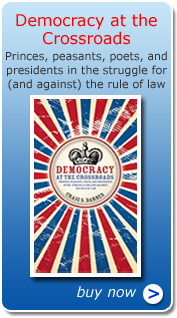In 1952, when I was 16, my father was stationed in the Air Force in London. I was dating a general’s daughter. I can still remember her kisses. They were luscious and the best experience to that point of my young life. Then one night in early September, just after a new American high school opened, I received a call from the girl’s father, the general.
“Hello, Craig, it’s General Kessinger. I understand you are planning a dance for the high school students at the American Teen Club,”
“Yes, sir.” I said, “I am working on it.” I had never had a call from a general before.
“This coming Saturday night?”
“Yes, sir.”
“I don’t suppose you will be allowing Negras to come to that dance, will you?”
There was a long pause at my end.
“Yes, sir,” I finally said. “They are in school too. It would be only fair.”
“It is not our custom to mix the races,” he said, “not socially.”
I told the general something, I think, about how hard it would be to change the announcement. Technically difficult.
My mother must have been listening. She chose that moment to come out into the hallway where I was standing, holding the phone. “Hold your ground,” she said quietly as she walked past, pretending to need something in the kitchen.
“This could cause a whole lot of problems that you do not understand,” said the general on the phone, “and I just don’t believe that this is the right time or place to make a social statement.”
“Maybe,” I hesitated, “we could set a good example ….”
Now the pause was at his end.
“And if you were to hold such a dance my daughter would not be able to come. No, she would not come to a dance like that, not at all.”
My mother walked back from the kitchen: “Hold your ground,” she whispered again.
As it turned out, I won the war but lost the girl. The whole matter eventually went to the commanding general of the Third Air Force who ordered that we be allowed to hold the dance and that everyone should be invited. I remember a young black girl came. Just one. She was dignified and pretty and I was full of admiration for her. In fact, she was stunning. The general’s daughter did not come. I never saw her again and never had another one of those delicious kisses.
Sixteen years later, I was practicing law in Denver when Martin Luther King, Jr., was killed. The city erupted in mass protests, meetings, school resolutions and turmoil. In the spring of 1969, I received a call asking if I would organize a lawsuit attempting to integrate Denver’s schools. Together with an aroused liberal community hundreds of volunteers began a process that prepared the facts and details of Denver’s history of school segregation. That segregation had all been informal and secret, never by rule of law. But there it was, hidden in the records of school admissions and boundaries, teacher assignments, bussing of whites out of black districts; the whole works.
As the trial opened in the Federal District Court in the winter of 1970, twenty-seven of our school buses were blown up. Dynamited. Boom, boom, boom.
Then one night our plaintiff’s house was blown up. Boom. Cars began to drive around my house, slowly, headlights off. Inside our house we were pretty nervous.
For nine years thereafter I was awakened with phone calls in the middle of the darkest hours. It was always more or less the same message: “Get up! Send your pretty little blond daughter to school with some niggers!” Click.
That year, later in the fall after the trial, I was the nominee for Congress of the Democratic Party in Denver. Two weeks before the vote, I had a fifteen-point lead in the polls. Then my opponent started running full-page ads in the papers charging me as the person responsible for Denver’s massed, forced, cross-town bussing . My 15-point lead evaporated overnight. In November, I was defeated.
Thirty-eight years later, I sat in the stadium at Invesco Field in Denver when 84,000 Democrats shouted and stamped their feet, screamed and yelled, sang and exalted when Barack Obama accepted the nomination of his party for the presidency of the United States of America. The same town that blew up the 27 school busses was holding a celebration that rocked the night. Fireworks and dancing, bombs bursting in air.
Last Wednesday, I went to the Fair Grounds of Santa Fe to vote. When I sat in that small booth and my pen came to the circle beside the name Barack Obama, an indescribable lump rose in my throat. With great care, I filled in the circle, over and over, and over, and over. Oh, my God, I thought, we have done it.
I went on, then, marking the circles in my ballot as if everything was normal. No shouting and exaltation rang out in the polling area. The election of a black man was now going to be a matter of course, of routine, of life in America.
For all of us in this country, this, or a variation of this, is our story. For me, this story began in 1952, when one high school identified and wrestled with the shadow of racism. In 1969, one city excavated, dug, wept and boiled over with the coming to light of the shadow. This year, a whole nation has not only identified, surfaced and called it by name, but has embraced its shadow, exalted over it, and the land of the free is more free than ever before.
